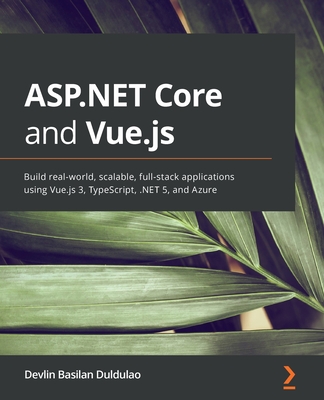Hands-On Microservices with C# 8 and .NET Core 3, 3/e (Paperback)
暫譯: 實戰微服務:使用 C# 8 和 .NET Core 3,第 3 版 (平裝)
Gaurav Aroraa , Ed Price , Scott Hanselman
- 出版商: Packt Publishing
- 出版日期: 2020-03-27
- 售價: $1,460
- 貴賓價: 9.5 折 $1,387
- 語言: 英文
- 頁數: 474
- ISBN: 1789617944
- ISBN-13: 9781789617948
-
相關分類:
.NET、C#、Microservices 微服務、SOA
無法訂購
買這商品的人也買了...
-
 jQuery Mobile 建置與執行 (jQuery Mobile: Up and Running)
jQuery Mobile 建置與執行 (jQuery Mobile: Up and Running)$520$411 -
 $599精通 C# 5.0 與 .NET 4.5 高級編程-LINQ, WCF, WPF 和 WF
$599精通 C# 5.0 與 .NET 4.5 高級編程-LINQ, WCF, WPF 和 WF -
 React Native 學習手冊 (Learning React Native: Building Native Mobile Apps with JavaScript)
React Native 學習手冊 (Learning React Native: Building Native Mobile Apps with JavaScript)$580$458 -
 王者歸來-PHP 完全開發範例集, 3/e
王者歸來-PHP 完全開發範例集, 3/e$860$731 -
Android 高效入門>>深度學習-使用 Android Studio 2 開發 Android 6.0 APP
$650$507 -
 $352大話代碼架構 (項目實戰版)
$352大話代碼架構 (項目實戰版) -
 OpenCV 3 學習手冊 (Learning OpenCV 3: Computer Vision in C++ with the OpenCV Library)
OpenCV 3 學習手冊 (Learning OpenCV 3: Computer Vision in C++ with the OpenCV Library)$1,200$948 -
 $474SQL 優化核心思想
$474SQL 優化核心思想 -
 $301Spring Data JPA 從入門到精通
$301Spring Data JPA 從入門到精通 -
 GraphQL 學習手冊 (Learning GraphQL : Declarative Data Fetching for Modern Web Apps)
GraphQL 學習手冊 (Learning GraphQL : Declarative Data Fetching for Modern Web Apps)$520$411 -
 30歲警官靠美股提早退休
30歲警官靠美股提早退休$350$277 -
 $454Spring 微服務架構設計, 2/e
$454Spring 微服務架構設計, 2/e -
 $607精通Spring Cloud微服務架構
$607精通Spring Cloud微服務架構 -
 $403Vue.js 入門與商城開發實戰
$403Vue.js 入門與商城開發實戰 -
 $866精通 ASP.NET Core MVC, 7/e (Pro ASP.NET Core MVC 2, 7/e)
$866精通 ASP.NET Core MVC, 7/e (Pro ASP.NET Core MVC 2, 7/e) -
 ASP.NET Core and Vue.js: Build real-world, scalable, full-stack applications using Vue.js 3, TypeScript, .NET 5, and Azure (Paperback)
ASP.NET Core and Vue.js: Build real-world, scalable, full-stack applications using Vue.js 3, TypeScript, .NET 5, and Azure (Paperback)$1,850$1,758 -
 領域驅動設計與 .NET Core:應用 DDD 原則,探索軟體核心複雜度 (Hands-On Domain-Driven Design with .NET Core)
領域驅動設計與 .NET Core:應用 DDD 原則,探索軟體核心複雜度 (Hands-On Domain-Driven Design with .NET Core)$780$585 -
 不當礦工當老闆:自己動手開發區塊鏈應用業務
不當礦工當老闆:自己動手開發區塊鏈應用業務$780$616 -
 Facebook 廣告投放操作祕笈:一看就懂 Facebook 商務套件操作
Facebook 廣告投放操作祕笈:一看就懂 Facebook 商務套件操作$548$433 -
 $403Xamarin 全棧開發技術與實踐 (微課版)
$403Xamarin 全棧開發技術與實踐 (微課版) -
 美股獲利入門,睡覺時間賺遍全世界:精選25檔增利股,年年發股利,提前布局未來四騎士,大賺價差。
美股獲利入門,睡覺時間賺遍全世界:精選25檔增利股,年年發股利,提前布局未來四騎士,大賺價差。$400$316 -
 Google 廣告投放必修課:給廣告投放新手的教學指南
Google 廣告投放必修課:給廣告投放新手的教學指南$450$356 -
 $458Spring Boot 企業級項目開發實戰
$458Spring Boot 企業級項目開發實戰 -
 Solidity 實戰全書:完整掌握智能合約!成為獨立開發 Dapp 的區塊鏈工程師
Solidity 實戰全書:完整掌握智能合約!成為獨立開發 Dapp 的區塊鏈工程師$650$507 -
 ASP.NET Core 工程師不可不知的 10大安全性漏洞與防駭方法
ASP.NET Core 工程師不可不知的 10大安全性漏洞與防駭方法$690$538
相關主題
商品描述
The microservice architectural style promotes the development of complex applications as a suite of small services based on specific business capabilities. With this book, you'll take a hands-on approach to build microservices and deploy them using ASP .NET Core and Microsoft Azure.
You'll start by understanding the concept of microservices and their fundamental characteristics. This microservices book will then introduce a real-world app built as a monolith, currently struggling under increased demand and complexity, and guide you in its transition to microservices using the latest features of C# 8 and .NET Core 3. You'll identify service boundaries, split the application into multiple microservices, and define service contracts. You'll also explore how to configure, deploy, and monitor microservices using Docker and Kubernetes, and implement autoscaling in a microservices architecture for enhanced productivity. Once you've got to grips with reactive microservices, you'll discover how keeping your code base simple enables you to focus on what's important rather than on messy asynchronous calls. Finally, you'll delve into various design patterns and best practices for creating enterprise-ready microservice applications.
By the end of this book, you'll be able to deconstruct a monolith successfully to create well-defined microservices.
|
商品描述(中文翻譯)
微服務架構風格促進了將複雜應用程式開發為一組基於特定業務能力的小型服務。透過這本書,您將採取實作方式來建立微服務,並使用 ASP .NET Core 和 Microsoft Azure 進行部署。
您將首先了解微服務的概念及其基本特徵。這本微服務書籍將介紹一個作為單體應用程式構建的實際應用,該應用目前在需求和複雜性增加的情況下面臨挑戰,並指導您如何使用 C# 8 和 .NET Core 3 的最新功能將其轉換為微服務。您將識別服務邊界,將應用程式拆分為多個微服務,並定義服務合約。您還將探索如何使用 Docker 和 Kubernetes 配置、部署和監控微服務,並在微服務架構中實現自動擴展以提高生產力。一旦您掌握了反應式微服務,您將發現保持代碼庫簡單使您能夠專注於重要的事情,而不是混亂的非同步調用。最後,您將深入探討各種設計模式和最佳實踐,以創建企業級的微服務應用程式。
在本書結束時,您將能夠成功地將單體應用程式解構為明確定義的微服務。
特點:
- 學習設計、實作、測試和部署您的微服務
- 了解測試和監控分散式服務的挑戰和複雜性
- 使用 C# 8 和 .NET Core 3.1 的最新功能構建模組化和穩健的微服務架構
作者簡介
Gaurav Aroraa
Gaurav Aroraa is a serial entrepreneur and start-up mentor. He has done an M.Phil in computer science. He is a Microsoft MVP award recipient. He is a lifetime member of the Computer Society of India (CSI), is an advisory member and senior mentor at IndiaMentor, is certified as a Scrum trainer/coach, is ITIL-F certified, and is PRINCE-F and PRINCE-P certified. He is an open source developer and a contributor to the Microsoft TechNet community. Recently, Gaurav was awarded "Icon of the year – excellence in Mentoring Technology Startups" for 2018-19 by Radio City, a Jagran initiative, for his extraordinary work during his 22-year career in the industry in the field of technology mentoring.
Ed Price
Ed Price is a senior program manager in engineering at Microsoft, with an MBA in technology management. He has run Microsoft customer feedback programs for Azure Development, Service Fabric, IoT, and Visual Studio. He was also a technical writer at Microsoft for 6 years, helped to lead TechNet Wiki, and now leads efforts to publish key guidance from AzureCAT (Customer Advisory Team), especially in the development of microservices. He is the coauthor of Learn to Program with Small Basic.
作者簡介(中文翻譯)
高拉夫·阿羅拉(Gaurav Aroraa)
高拉夫·阿羅拉是一位連續創業家和初創企業導師。他擁有計算機科學的碩士學位(M.Phil)。他是微軟 MVP 獎的獲得者,也是印度計算機學會(Computer Society of India, CSI)的終身會員,並擔任 IndiaMentor 的顧問成員和高級導師。他持有 Scrum 培訓師/教練的認證,ITIL-F 認證,以及 PRINCE-F 和 PRINCE-P 認證。他是一位開源開發者,也是微軟 TechNet 社區的貢獻者。最近,高拉夫因其在技術導師領域的卓越工作,在其 22 年的職業生涯中,於 2018-19 年獲得了 Radio City(Jagran 旗下)頒發的「年度偶像 – 技術初創企業導師卓越獎」。
艾德·普賴斯(Ed Price)
艾德·普賴斯是微軟工程部的高級項目經理,擁有技術管理的 MBA 學位。他負責微軟 Azure 開發、Service Fabric、物聯網(IoT)和 Visual Studio 的客戶反饋計劃。他曾在微軟擔任技術寫作員 6 年,幫助主導 TechNet Wiki,現在負責發佈 AzureCAT(客戶顧問團隊)的關鍵指導,特別是在微服務的開發方面。他是《學習使用 Small Basic 編程》的共同作者。
目錄大綱
- An Introduction to Microservices
- Refactoring the monolith
- Effective communication between services
- Testing Microservices with Microsoft Unit Testing Framework
- Deploying microservices with Docker
- Securing Microservices using Azure Active Directory
- Monitoring microservices
- Scaling microservices with Azure
- Introduction to Reactive Microservices
- Design Patterns and Best Practices
- Building Microservice Application
- Microservices Architecture Summary
- Appendix
目錄大綱(中文翻譯)
- An Introduction to Microservices
- Refactoring the monolith
- Effective communication between services
- Testing Microservices with Microsoft Unit Testing Framework
- Deploying microservices with Docker
- Securing Microservices using Azure Active Directory
- Monitoring microservices
- Scaling microservices with Azure
- Introduction to Reactive Microservices
- Design Patterns and Best Practices
- Building Microservice Application
- Microservices Architecture Summary
- Appendix


















